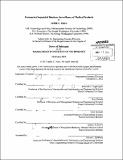Postmarket sequential database surveillance of medical products
Author(s)
Maro, Judith C
DownloadFull printable version (27.77Mb)
Other Contributors
Massachusetts Institute of Technology. Engineering Systems Division.
Advisor
Deborah J. Nightingale and Roy Welsch.
Terms of use
Metadata
Show full item recordAbstract
This dissertation focuses on the capabilities of a novel public health data system - the Sentinel System - to supplement existing postmarket surveillance systems of the U.S. Food and Drug Administration (FDA). The Sentinel System is designed to identify and assess safety risks associated with drugs, therapeutic biologics, vaccines, and medical devices that emerge post-licensure. Per the initiating legislation, the FDA must complete a priori evaluations of the Sentinel System's technical capabilities to support regulatory decision-making. This research develops qualitative and quantitative tools to aid the FDA in such evaluations, particularly with regard to the Sentinel System's novel sequential database surveillance capabilities. Sequential database surveillance is a "near real-time" sequential statistical method to evaluate pre-specified exposure-outcome pairs. A "signal" is detected when the data suggest an excess risk that is statistically significant. The qualitative tool - the Sentinel System Pre- Screening Checklist - is designed to determine whether the Sentinel System is well suited, on its face, to evaluate a pre-specified exposure-outcome pair. The quantitative tool - the Sequential Database Surveillance Simulator - allows the user to explore virtually whether sequential database surveillance of a particular exposure-outcome pair is likely to generate evidence to identify and assess safety risks in a timely manner to support regulatory decision-making. Particular attention is paid to accounting for uncertainties including medical product adoption and utilization, misclassification error, and the unknown true excess risk in the environment. Using vaccine examples and the simulator to illustrate, this dissertation first demonstrates the tradeoffs associated with sample size calculations in sequential statistical analysis, particularly the tradeoff between statistical power and median sample size. Second, it demonstrates differences in performance between various surveillance configurations when using distributed database systems. Third, it demonstrates the effects of misclassification error on sequential database surveillance, and specifically how such errors may be accounted for in the design of surveillance. Fourth, it considers the complexities of modeling new medical product adoption, and specifically, the existence of a "dual market" phenomenon for these new medical products. This finding raises non-trivial generalizability concerns regarding evidence generated via sequential database surveillance when performed immediately post-licensure.
Description
Thesis (Ph. D.)--Massachusetts Institute of Technology, Engineering Systems Division, 2013. Cataloged from PDF version of thesis. Includes bibliographical references (p. 193-212).
Date issued
2013Department
Massachusetts Institute of Technology. Engineering Systems DivisionPublisher
Massachusetts Institute of Technology
Keywords
Engineering Systems Division.